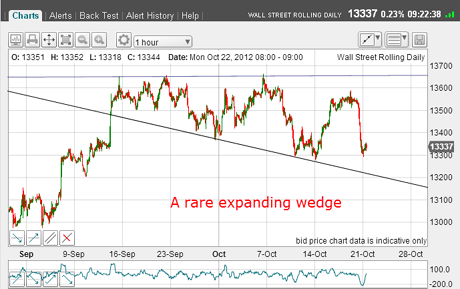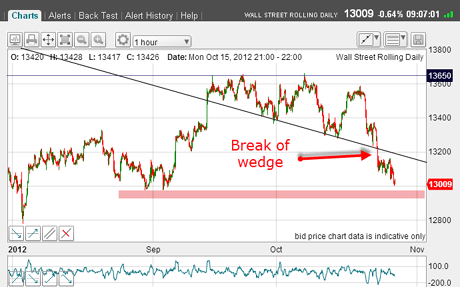How I took 450 pips out of the Dow this morning
In a trade that perfectly illustrates the low-stress nature of using his simple trading and money management rules, John C Burford takes a 450-pip profit from the Dow.
This afternoon I want to follow up Monday'spost on the Dow, since it perfectly illustrates the low-stress nature of trading with my very simple trading and money management rules.
I fervently believe that many traders trade emotionally, allowing themselves to be whipsawed one way and then the other by the news. That's something I observed at the recent MoneyWeek Trader workshops.
Not only that, but when you have a long position, say, and the news is suddenly bearish, there can be an urge to kill the trade and override any stop-loss policy you may have. You may even be tempted to reverse your original position.
MoneyWeek
Subscribe to MoneyWeek today and get your first six magazine issues absolutely FREE

Sign up to Money Morning
Don't miss the latest investment and personal finances news, market analysis, plus money-saving tips with our free twice-daily newsletter
Don't miss the latest investment and personal finances news, market analysis, plus money-saving tips with our free twice-daily newsletter
Usually, this is a disastrous way to trade. And if the market continues going in your direction (without you), your confidence will be shattered. Your stress levels ramp up and you are in no state to make a rational analysis of the markets.
Also, it is so very tempting to follow the gurus and do what they say they are doing after all, they must have a lot more knowledge and skill than you, surely? These are the well-known and well-publicised names we are all familiar with.
When one guru tells you that gold is going to $5,000, you need to question whether that was what he or she actually said, whether it was heavily qualified (for example, "if gold can reach $3,000, it should make $5,000"), or whether they are engaging in ramping the price so as to sell their gold at higher prices.
With all of these questions, I treat what the gurus have to say with a pinch of salt. I suggest you do likewise.
When a losing trade is a good trade
OK back to the Dow. When I left it on Monday, I spotted the wedge formation that gave me pause for my bear position. This was the chart then:

(Click on image above for larger version)
I had my short position taken at the 13,500 area and had moved my protective stop to break-even.
I had wondered if the market would make another stab at the upper horizontal line again. After all, we are still in a major bull market on the daily chart. There was a very real possibility that investors would get the QE infinity bit between their teeth and push up shares to new highs.
But I was not concerned about it! If that did occur, I would be taken out of my trade with no loss. That was my worst case scenario.
I cannot over-emphasise how comfortable that made me feel! But imagine if you were just playing this trade by ear'! I guarantee that if the market rallied back to the 13,500 area, you would be in high-stress mode.
You might decide to over-ride your stop, or move it up higher to give the trade more room'.
I would advise anyone considering this approach to trading to either cease trading and give your trading account to charity (the same net result to you), or to get serious and have a rock-solid money management plan.
And one other point don't get hung up on your losses. We cannot predict the market with 100% accuracy. All traders even very successful ones have lots of losing trades. If you enter the trade following your rules and it loses money, it's still a good trade! That's because you showed discipline in adhering to your plan.
As we now know, the market did not make that rally attempt and here is the situation this morning:

(Click on image above for larger version)
On Tuesday, the market plunged down through the lower wedge line and solved my dilemma. This occurred despite generally bullish' reports from the US.
If you reacted to this news, you might take a long trade, or cut your shorts.
Always let the market decide!
Now, the market is working its way through the congestion zone support from September and is challenging the previous low just under 13,000 (pink bar).
So now I have a nice problem where to move my protect-profit stop?
The subject of stop-losses is a difficult area, and there are no hard-and-fast rules. But one major consideration is this: what is the timeframe of your trade? If you are taking a long timeframe, you will place wide stops. If trading short-term, you would use tighter stops.
So with this week's large declines, what does the daily chart look like? This was the picture on Monday:

(Click on image above for larger version)
I had my first major target at 13,000. This is the picture now:

(Click on image above for larger version)
That's nice. But, having hit my target, the market has also hit support at the Fibonacci 38% level. Hmmm. Time for a bounce, perhaps?
There may be a rally ahead
And gazing over to the gold chart (the Dow and gold trade roughly in sync), I see support coming in at the $1,700 area (see Wednesday's post). Another reason to suspect a rally ahead.
And here is another:

(Click on image above for larger version)
This is the higher-beta Nasdaq and it has collapsed to the Fibonacci 62% retrace, and is eating into major chart support.
If I were trading short-term, I would be looking at this level to take a tidy 450 pip-plus profit, of course. And that would be a textbook low-stress trade. My only real risk was at the start where I had my stop around 75 pips away.
The reward/risk ratio is over six-to-one a very high return. Most of my short-term successful trades are in the two or three-to-one range.
As it happened, this trade was never in debit as the market moved swiftly down after entry. Talk about low-stress!
Now, if you can find a way, using my very simple money management rules to reduce or eliminate stress, I am confident your performance will shoot up to the next level.
If you're a new reader, or need a reminder about some of the methods I refer to in my trades, then do have a look at my introductory videos:
The essentials of tramline trading
An introduction to Elliott wave theory
Advanced trading with Elliott waves
Don't miss my next trading insight. To receive all my spread betting blog posts by email, as soon as I've written them, just sign up here . If you have any queries regarding MoneyWeek Trader, please contact us here.
Get the latest financial news, insights and expert analysis from our award-winning MoneyWeek team, to help you understand what really matters when it comes to your finances.
John is is a British-born lapsed PhD physicist, who previously worked for Nasa on the Mars exploration team. He is a former commodity trading advisor with the US Commodities Futures Trading Commission, and worked in a boutique futures house in California in the 1980s.
He was a partner in one of the first futures newsletter advisory services, based in Washington DC, specialising in pork bellies and currencies. John is primarily a chart-reading trader, having cut his trading teeth in the days before PCs.
As well as his work in the financial world, he has launched, run and sold several 'real' businesses producing 'real' products.
-
 The most influential people of 2025
The most influential people of 2025Here are the most influential people of 2025, from New York's mayor-elect Zohran Mamdani to Japan’s Iron Lady Sanae Takaichi
-
 Millions of parents are missing out on up to £720 a year in extra pension cash – are you affected?
Millions of parents are missing out on up to £720 a year in extra pension cash – are you affected?A mum who narrowly missed out on the pension boost said she “never knew the government rule existed” and wants other parents to use it